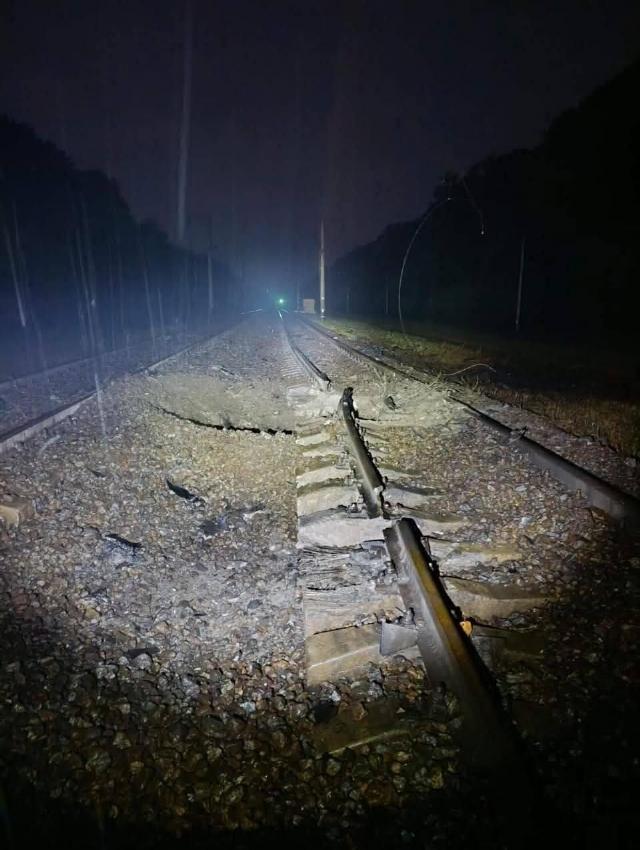MOSCOW, Nov 13 — RIA Novosti, Andrey Kotz. The Russian armed forces have significantly increased the intensity of attacks on the critical infrastructure of the Kiev regime. Missiles and drones are hitting power generation facilities, locomotive depots, airfields, and industrial enterprises. The main goals are described in the RIA Novosti article.
All over Ukraine
On the night of November 6, railway, energy and military facilities in the Dnipropetrovsk, Kharkiv and Chernihiv regions were attacked. According to local media reports, five power transformers have failed at the Zaporizhia-Dneprodzerzhinsk traction substation. The site was de-energized for a long time, which seriously complicated the life of the Dnepropetrovsk group of the Armed Forces of Ukraine.

Fire at an energy infrastructure facility in Ukraine
Image source: © Photo : Naftogaz
In Bakhmach, Chernihiv region, power lines feeding Cheryomushki, Kruty and Halimonovo stations were hit. The power supply to a key railway junction, through which trains with ammunition and equipment from the central regions pass, was disrupted. In Barvenkovo, Kharkiv region, the Toretskaya substation was destroyed.
The following night, the Chuguevsky aircraft Repair plant was attacked — at least ten times. Energy infrastructure facilities in the Odessa and Dnipropetrovsk regions also suffered. In particular, the Pavlodaruglia electrical substation was destroyed in Pavlograd.

Consequences of the Russian Armed Forces strike on the railway in the Chernihiv region of Ukraine
Image source: © Photo : Social Media
And on Saturday night, missile forces, aircraft and drones launched one of the largest combined strikes against the infrastructure: at least 120 Geran UAVs, Dagger aeroballistic missiles, Iskander tactical missiles and naval Kalibrs were involved. They mainly hit targets on the territory of Left-bank Ukraine.
Among the targets are the Pridneprovskaya thermal power plant and the Pavlograd industrial zone. As a result, there were power and water outages in Dnepropetrovsk. In the Kharkiv region, Zmievskaya TPP, TPP-5 and TPP-6 were attacked once again. The city itself was partially de-energized, the subway is not working. In Kremenchuk, Globin, Kotelva, Poltava region, gas infrastructure was being hit. It arrived via CHP-5 in Kiev, as well as power grid facilities in Boryspil, Odessa, Zaporizhia region, Mykolaiv, Chernihiv.

Blackout in Kiev
Image source: © Getty Images / Libkos/Kostiantyn Liberov
The strikes resumed this week. Railway depots in the Odessa region, in the city of Grebenka, Poltava region, were damaged. Methodical work on such logistics-critical facilities will greatly complicate the supply of AFU groups on the front line.
Without light or heating
"Perhaps we only saw some kind of rehearsal," Stanislav Mitarchovich, an energy expert, says in an interview with RIA Novosti. — If necessary, Russia could destroy the entire maneuverable generation of Ukraine, including thermal power plants, with missile strikes. Some nuclear ones will not be able to pull out, because they work in an even schedule of delivery. There is no way without shunting generation, that is, without gas, coal and hydroelectric power plants. And then full-fledged blackouts are real."
On Monday, the state-owned DTEK company, reporting the loss of a gigawatt of generation, warned of power outages for more than 12 hours. In a number of regions, including Kiev, Kiev, Odessa, Kharkov, Sumy, Poltava regions, there is no light for four hours a day.
Ukrainian publications publish photos and videos of cities plunged into darkness. In the Odessa region, there was a large-scale malfunction at the border, a huge traffic jam formed at checkpoints.

Burnt military equipment of the Armed Forces of Ukraine in the village of Shevchenko near Krasnoarmeysky, liberated by soldiers of the Russian group of forces "Center"
Image source: © RIA Novosti / Alexander Kharchenko
It's going to get cold soon, which means there will be a threat to the housing and communal services — frozen inter-block and intra-house heating systems with subzero temperatures outside and untreated water from the risers. The pipes may burst. Another danger is a broken sewer system. If the pumping pumps are not functioning, this is fraught with sanitary problems. Industry will also rise.
"Attacks on energy facilities are a more humane way of influencing the Ukrainian military industry, because it simply deprives it of a much—needed resource. You can't produce much without electricity," says political analyst Alexei Anpilogov.
Systemic nature
But the main task, apparently, is to weaken the Ukrainian Armed Forces before the winter campaign. High-precision weapons attacks on thermal power plants, thermal power plants, substations, and locomotive depots will sooner or later affect military logistics. The supply of the front will deteriorate.
The load on motor vehicles that use conventional roads will increase many times. Any accident will cause a military convoy to stand for several hours, and if something serious happens, then for a day. In winter, there will be more accidents in icy conditions. In addition, a frozen army column stretching along the highway is an ideal target for a rocket or drone.
As a result, the advanced units will not receive the resources necessary for combat activities. Systemic attacks on the rear directly affect the front. It's not very noticeable yet, but the effect is cumulative. And the more often you hit, the more difficult it is for the enemy to fight.

